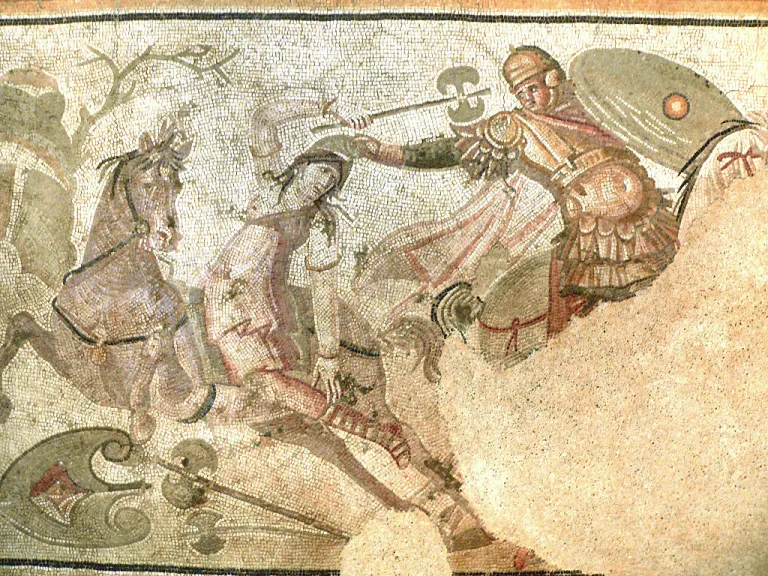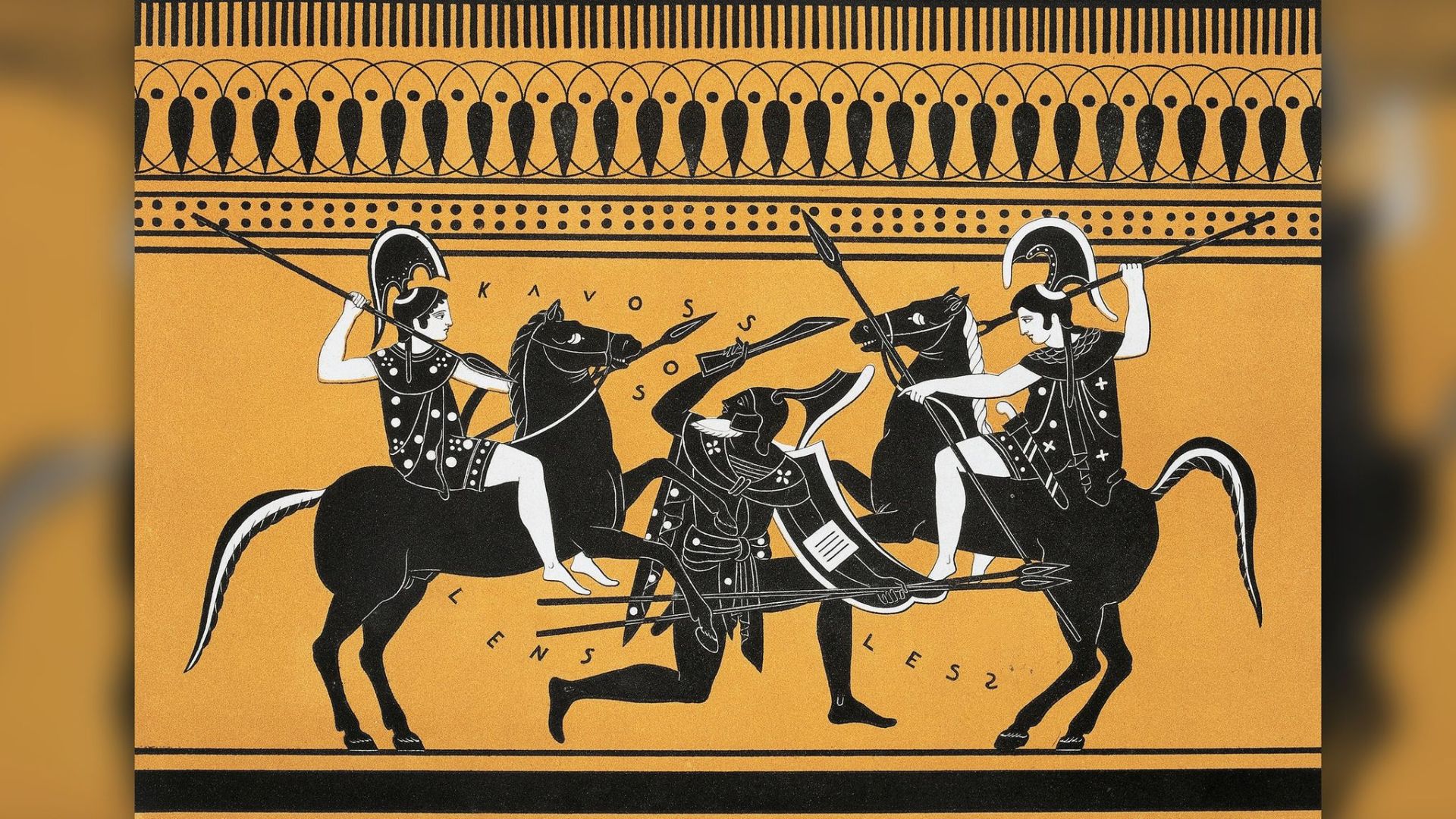By Connie Skibinski, PhD candidate at the University of Newcastle.
Imagine a society run by women for women, where men are only used for breeding purposes. Women who can rule themselves, found distant lands, and beat men in battle. It may sound like some far-fetched futuristic society, yet stories of the Amazons have been told since pre-Homeric times.
Though it was long assumed that the Amazons were purely fictitious figures, historian and classical folklorist Adrienne Mayor illustrates that they were based (in part) on historical fact, influenced by the Greek’s observations of the Scythians. Archaeological evidence indicates that Scythian women were engaged in hunting and warfare alongside men and were proficient with a bow and arrow, the choice weapons of the Amazons.
In Greco-Roman mythology, these real historical elements were embellished to create compelling narratives. Amazons are the daughters of Ares – the God of War – who devote their time to hunting and war-training. They put up a formidable and unflinching fight against many renowned Greek heroes, including Herakles, Theseus and Achilles. The Amazons represented an extreme inversion of the patriarchal status quo, as Strabo (1st century BC) describes them as an all-female society capable of governing their own people, conquering distant lands and founding cities – all without the aid of men.
Of course, there was never an all-female society in the ancient Greek world. In fact, women there lived under the rule of men and weren’t even considered citizens. Yet, the notion of powerful women living independently from men has continued to fascinate audiences across the millennia. In our own era this come into sharper focus with the growth of the feminist movement, as we look to the past to see how these mythical women can speak to the world today. The Amazons’ autonomy and proficiency in traditionally masculine realms has made them the perfect candidates to be refashioned as contemporary feminist icons. Here I will look at representations of two such women in recent films: Wonder Woman and Andromachie.
Wonder Woman: Modern-day Amazon and Feminist Icon
Wonder Woman (Warner Bros., 2017 & 2020) invokes the ancient Amazon warrior – but with a superhero twist. As princess of Themiscyra and daughter of the Amazon Queen Hippolyta, her connection to Greek mythology is made explicit. Like the ancient Amazons, she was taught to fight from a young age, undergoing intensive war-training in her homeland. As part of the superhero tradition, she also has superhuman powers which surpass those of her counterparts in ancient myth, such as superspeed, superstrength, and the ability to fly. With these attributes she can transcend the limits of human potential, regardless of gender, and is a formidable opponent for anyone who stands against her.

Image: Jackee Lainebla MC (Wikicommons)
As an Amazon warrior endowed with superhuman abilities, Wonder Woman does not shy away from warfare. In her debut in All Star Comics #8 (DC Comics, 1941), she helps US intelligence officer Steve Trevor fight Nazi forces. The feature film Wonder Woman (2017) is also set in war times, but revolves around her attempts to stop World War I by defeating Ares, the god responsible for the conflict. The 2020 film Wonder Woman 1984 shows a more complex attitude towards violence. Wonder Woman has an extensive fight scene with the antagonist Cheetah, but refrains from fighting the archvillain Maxwell Lord, instead convincing him to renounce his power of his own accord. Nonetheless, she is willing to use violence against her opponents, when innocent citizens’ lives are at threat. This points to a striking divergence from the ancient myths. While the ancient Amazons revelled in war for its own sake, Wonder Woman only fights for the end means of achieving justice, in true superhero fashion.
From her DC Comic debut in 1941, the character of Wonder Woman had strong feminist underpinnings. Her creator, William Moulton Marston, was an outspoken feminist and supporter of the suffragette movement. He sought to challenge the damsel in distress trope by creating a strong and empowered female hero who “encourages women to stand up for themselves, to learn to fight, and be strong, so they don’t have to be scared, or depend on men”. With his focus on female empowerment and independence, it is no surprise that Marston turned to the mythic Amazons for inspiration. Their all-female matriarchal society perhaps held special appeal in this first-wave feminist context. Wonder Woman saw renewed appeal during the 1960s, emerging with the rise in second-wave feminism. Feminist activist Gloria Steinem saw her as a positive female role model, representing gender equality and the importance of sisterhood. The cover of first issue of Steinem’s Ms. magazine (1972) featured one of Marston’s illustrations along with the title “Wonder Woman for President”, cementing Wonder Woman’s place as a feminist icon.[1]
Even now, decades after Wonder Woman’s debut, she continues to be a powerful female role model. In 2016, the United Nations chose Wonder Woman as the ‘Honorary Ambassador for the Empowerment of Women and Girls.’ Gal Gadot – who played the starring role in Wonder Woman (2017) and Wonder Woman 1984 (2020) – also sees the character as a role model for young women, upholding the values of love, compassion, acceptance and truth.
However, no singular feminist icon can appeal to all women. There are many who feel that her sexualised appearance furthers the objectification of women, reinforcing male fantasies surrounding the female body. There is also the issue of her lack of intersectionality – as a young, (generally perceived as) straight woman who adheres to traditional (Eurocentric) standards of beauty, Wonder Woman’s image may be alienating to women with differing lived experiences. For some of these women, perhaps The Old Guard’s Andromache is a more relatable role model.
Netflix’s The Old Guard (2020) – based on Greg Rucka’s[2] 2017 comic book series of the same name – provides another striking example of an ancient warrior woman refashioned for the modern day. Andromache the Scythian (Andy) leads a team of immortal warriors who intervene in history for the betterment of humanity. Initially, Andy is elusive about her origins. As the film progresses, small details emerge which hint at her ancient past. She mentions that she was once worshipped as a God, and numerous flashbacks show her in elaborately embroidered ancient clothing, fighting on horseback with a bow and arrow.
This all comes together when we see the information that James Copley (a former CIA operative) has gathered about Andy and the other immortals. Referring to her as “the eternal warrior”, Copley stands in front of a bulletin board covered in ancient paraphernalia. This includes: a mosaic of an Amazon fighting a Greco-Roman soldier; a page from Jean Racine’s Andromaque (based on Euripides’ Andromache); an old map of Scythia; and a photograph of a labrys (double-headed axe). This situates Andy as a millennia old Scythian warrior, with strong links to Amazon mythology.

As an eternal warrior, Andy has lived through countless battles and wars, and is desensitized to violence. Throughout the film, she engages in multiple combat scenes, fighting off (predominantly male) opponents with her battle-axe and gun. And yet, Andy never kills gratuitously. She has a strong respect for human life, only killing if it is necessary to save innocent people, or protect her fellow immortals. Much like Wonder Woman, Andy uses violence as a tool for justice, and is therefore a heroic figure.
Conclusion
Through the creation of strong female characters like Wonder Woman and Andromache the Scythian, the legacy of ancient warrior women lives on in the modern day, while being adjusted to suit the changing interests of the contemporary audience. In both the ancient and modern world, representations of Amazons shed light on societal attitudes towards women. To the ancient male audience, the Amazons reflected the polar opposite of the ideal subservient woman, thus providing a model of how women shouldn’t be. By contrast, in our contemporary feminist climate, Wonder Woman and Andy are positive role models for women and girls, standing as powerful examples of female strength and compassion.
Connie Skibinski is a PhD (Classics) candidate at The University of Newcastle, having completed an honours degree in Ancient History/Ancient Greek at The University of Sydney. Her doctoral research examines the complex and multifaceted portrayal of the Amazons in ancient literature and art, and analyses how Amazon mythology has been reconfigured from the Medieval era to the twenty-first century. Connie was interviewed by ABC Radio National to discuss mythological links in ‘Wonder Woman 1984’ (2021) when the movie debuted, and she continues to explore modern receptions of Amazon mythology, currently focusing on the Amazons in ‘Xena: Warrior Princess’.
[1] Wonder Woman has repeatedly featured on the cover of Ms Magazine, particularly on anniversary issues.
[2] Greg Rucker also worked on Wonder Woman titles during his time at DC

